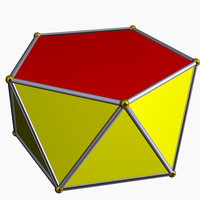Pentagonal antiprism
| Pentagonal antiprism | |
|---|---|
 | |
| Rank | 3 |
| Type | Uniform |
| Notation | |
| Bowers style acronym | Pap |
| Coxeter diagram | s2s10o ( |
| Conway notation | A5 |
| Elements | |
| Faces | 10 triangles, 2 pentagons |
| Edges | 10+10 |
| Vertices | 10 |
| Vertex figure | Isosceles trapezoid, edge lengths 1, 1, 1, (1+√5)/2 |
| Measures (edge length 1) | |
| Circumradius | |
| Volume | |
| Dihedral angles | 3–3: |
| 5–3: | |
| Height | |
| Central density | 1 |
| Number of external pieces | 12 |
| Level of complexity | 4 |
| Related polytopes | |
| Army | Pap |
| Regiment | Pap |
| Dual | Pentagonal antitegum |
| Conjugate | Pentagrammic retroprism |
| Abstract & topological properties | |
| Flag count | 80 |
| Euler characteristic | 2 |
| Surface | Sphere |
| Orientable | Yes |
| Genus | 0 |
| Properties | |
| Symmetry | (I2(10)×A1)/2, order 20 |
| Convex | Yes |
| Nature | Tame |
The pentagonal antiprism, or pap, is a prismatic uniform polyhedron. It consists of 10 triangles and 2 pentagons. Each vertex joins one pentagon and three triangles. As the name suggests, it is an antiprism based on a pentagon.
It can also be obtained as a diminishing of the regular icosahedron when two pentagonal pyramids are removed from opposite ends.
Vertex coordinates[edit | edit source]
A pentagonal antiprism of edge length 1 has vertex coordinates given by:
These coordinates are obtained by removing two opposite vertices from a regular icosahedron.
An alternative set of coordinates can be constructed in a similar way to other polygonal antiprisms, giving the vertices as the following points:
Representations[edit | edit source]
A pentagonal antiprism has the following Coxeter diagrams:
- s2s10o (alternated decagonal prism)
- s2s5s (alternated dipentagonal prism)
- xo5ox&#x (bases considered separately)
General variant[edit | edit source]
The pentagonal antiprism has a general isogonal variant of the form xo5ox&#y that maintains its full symmetry. This variant uses isosceles triangles as sides.
If the base edges are of length b and the lacing edges are of length l, its height is given by .
The bases of the pentagonal antiprism are rotated from each other by an angle of 36°. If this angle is changed the result is more properly called a pentagonal gyroprism.
A notable case occurs as the alternation of the uniform decagonal prism. This specific case has base edges of length and side edges of length .
Related polyhedra[edit | edit source]
A pentagonal pyramid can be attached to a base of the pentagonal antiprism to form the gyroelongated pentagonal pyramid. If a second pyramid is attached to the other base, the result is the gyroelongated pentagonal bipyramid, better known as the regular icosahedron.
Two non-prismatic uniform polyhedron compounds are composed of pentagonal antiprisms:
There are also an infinite amount of prismatic uniform compounds that are the antiprisms of compounds of pentagons.
External links[edit | edit source]
- Bowers, Jonathan. "Batch 2: Ike and Sissid Facetings" (#3 under ike).
- Klitzing, Richard. "pap".
- Quickfur. "The Pentagonal Antiprism".
- Wikipedia contributors. "Pentagonal antiprism".
- McCooey, David. "Pentagonal Antiprism"













